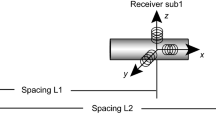Abstract
Herewith, two borehole directional geoelectrical configurations have been introduced for the detection of deep conductors not intersected by the well. The first one is a hole to surface configuration (HSC) using the dc current, and the second one is a telluric configuration (TC). Characterized by a deeper penetration depth, and a directional effect, both configurations have superiority comparable with other traditional geoelectrical configurations. Basically, a Directional Natural Induced Polarization methodology termed (DNIP) has been developed and proposed by benefiting from borehole telluric measurements taken at two sufficiently low frequencies. These configurations have been tested in the Rouez mine, Bretagne, France, where sulphide mineralization is known to occur. Several anomalies have been isolated in field data and interpreted by different interpretative techniques. The results obtained by applying these configurations are in good agreement, and the detected conductors are confirmed by morphological and lithological description.
Similar content being viewed by others
Author information
Authors and Affiliations
Corresponding author
Rights and permissions
About this article
Cite this article
Asfahani, J. Directional Borehole Logging Configurations Using DC and Telluric Methods for Detecting Deep Conductors Not Intersected by Wells. Pure appl. geophys. 162, 2523–2556 (2005). https://doi.org/10.1007/s00024-005-2785-5
Received:
Accepted:
Published:
Issue Date:
DOI: https://doi.org/10.1007/s00024-005-2785-5




